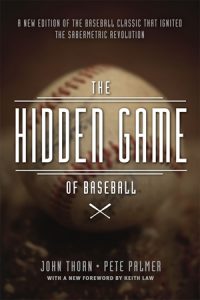Talking baseball with John Thorn, official historian of Major League Baseball and coauthor of The Hidden Game



(John Thorn, photo by Alison Richards; Bill Savage, photo by Rich Lalich.)
In 1984, John Thorn and Pete Palmer helped launch what would become the sabermetric revolution in baseball by publishing The Hidden Game of Baseball: A Revolutionary Approach to Baseball and Its Statistics. More than thirty years later, we have seen the game of baseball absorb the insights of Thorn, Palmer, and those who came in their wake in a way that no one could ever have predicted back in the days when RBI, batting averages, and pitcher wins were king.
In 2015, we were proud to bring The Hidden Game back into print. To kick off the baseball playoff season, we hooked up our old friend Bill Savage, lit prof and Cubs fan, with John Thorn to talk about the book and the game.
In The Hidden Game, you and Pete Palmer helped explain new forms of baseball statistics to fans (and the powers-that-be in The Game). Many of these stats have come to be widely accepted, despite the stubborn adherence to BA/HR/RBI and W/L records among the more retrograde fans. Which of the even more recent statistical categories do you think most add to our understanding and enjoyment of players’ accomplishments?
I admire the work of modern statistical analysts even as, over the years, my interests have drifted more to the history of the game, particularly its earliest period—even before statistics entered the discussion of which player was better than another. Voros McCracken’s FIP (Fielding Independent Pitching) has seemed to me to be a great breakthrough in the way we look at the game, and how we measure it. BABIP (Batting Average on Balls in Play) is also a solid new stat, as it reveals the good luck or bad that may inform short-term outcomes. WAR (Wins Above Replacement) is a refinement of Pete Palmer’s Linear Weights System, with the principal difference being its baseline of a mythical replacement player (available via callup from Triple-A) rather than the LWTS baseline of zero. The latter still seems to me more elegant mathematically and philosophically, as an average team will go 81-81 and thus provide no extra wins above a team that is 0-0 on Opening Day.
What’s your take on the new measurements of hitters (launch angle and exit velocity) that are based primarily on technological advances rather than new mathematical ways of framing the game’s data points? Back in the day, people might have seen such things but not have been able to quantify them.
Interesting . . . which is to say that I am interested in their likely assistance in evaluating hitters’ future chances and perhaps their suitability in certain trade ruminations. I am not, however, impressed by these measures’ in-game or in-season utility. They seem to me to be the shiny tinsel on the otherwise perfect tree.
The powers-that-be in MLB are concerned with how long a game takes—but recent research by Grant Bisbee of SBNation.com (comparing two games with strong statistical parallels, from 1984 and 2014 https://www.sbnation.com/a/mlb-2017-season-preview/game-length) suggests that the difference between today’s game and the game of a generation ago is simply how long pitchers take to throw the ball. Why not just have a 20-second pitch clock, as some minor leagues do?
As it has turned out, few pitchers exceed the 20-second mark with any regularity, so this argument may be moot, or at least window dressing, compared to other problems of pace/length, e.g., number of relief pitchers used, number of pitches thrown (deep counts), time between balls put into play (“Three True Outcomes”), and so on.
The powers-that-be in MLB are also worried about their aging fan base, and blame pace-of-play and length of games for a potentially lost generation of young fans. But my experience is that some young people (many of my students at Northwestern, for instance) love baseball, and the pauses inherent in the game fit with their constant fiddling with phones, Tweeting and texting. (Ahem. I have been known to tweet between innings as well.) If you could mandate anything to get younger fans into baseball, what would it be?
This is above my pay grade, of course—I work for the Commissioner but do not presume to mandate anything. As an advanced fan, however, I might speculate that more balls in play, fewer strikeouts, and fewer situational relievers might well make the game more appealing to fans of any age.
Part of baseball’s historic continuity is the relative stability of the rules, with the lowered pitcher’s mound and the DH being prominent counter-examples. Is it worth changing fundamental rules to speed up the game? The gesture for an intentional walk, starting extra innings with a runner on second, and so forth? Some sports chatterers are even suggesting making the game 7 innings long. I’d (unseriously) suggest just starting every batter with a 1-1 count, like in park district softball. How should baseball balance historical continuity with modern demands?
I think most fans do not appreciate the fairly violent gyrations in the rules that characterized the game into the twentieth century, and those that characterized the 1960s and early ’70s. Baseball has always had an experimental quality—just as one might say of the America’s evolving adventure into democracy. Both the nation and its pastime may be viewed as solid, inert institutions, inhospitable to change, yet that is not the way I see either. Continuity, yes; obdurate resistance, no. Traditionalists will tend to be older and bound to affirm their life’s experience of baseball (or America). But older fans, while they may dominate today’s marketplace of ideas, do not represent the economic marketplace of tomorrow.
Baseball is America’s most ancient and historic game—yet many people think MLB doesn’t do enough to teach its history to current or potential fans. As MLB’s official historian, how would you like to see teams in MLB (and the minors) use the game’s history to enrich the fan experience?
My dear departed friend Larry Ritter, author of The Glory of Their Times (1966), liked to say that the best part of baseball today is its yesterdays. For older fans, certainly that is true. But I think baseball’s past enriches the experience of younger fans, too, and when a seemingly unique event resonates across the canyons of time to recall another, similar happenstance, the effect is warming, enriching, beautiful. I believe that my mission as MLB’s official historian is to share the pleasure I experience in making such connections, and perhaps to inspire a new generation to explore the depths of this endlessly fascinating game. No sport connects with its past on a daily basis the way that baseball does. Babe Ruth, Ty Cobb, Cy Young, Christy Mathewson, Walter Johnson—these are names that all baseball fans know and revere. Can the same be said of our other team sports—say, for Red Grange (football), or George Mikan (basketball), or Howie Morenz (hockey)?
One huge issue lately is cultural differences between “old school” baseball people and younger players, especially stars from Latin America, who play with more overt emotion and exuberance. This moment parallels the reaction of many players, coaches, and executives to how Negro League players brought their style of play to the Bigs after Jack Robinson’s debut. It seems ironic that MLB can simultaneously worry about not appealing to young fans, and criticize players whose style might very well appeal to such young fans, accustomed as they are to the more emotionally-charged behavior on basketball courts and football fields. The term often used in this conversation is about “respecting the game.” What does it mean, to you, to “respect the game”?
Respecting the game has meant different things in different eras. The ungovernably rowdy 1890s nearly placed baseball permanently in the shade, trailing college football, cycling, golf, and automobile races. When decorum returned to the game, female fans did too. In the 1950s, Mickey Mantle ran around the bases with his head down after a home run, so as not to show up the pitcher. Given its roots in sublimated martial activity, baseball has sometimes struggled to strike a balance between chivalry and bravado. I am utterly confident that it will do so again, embracing Hispanic conventions while not abandoning North American reserve.
Electronic strike zone: Yes or No? If yes, how?
It may come. Certainly cricket and tennis have accommodated it. I have always accepted mistakes as an inevitable feature of human endeavor, and almost miss the vanishing error in the field as much as I miss the triple. But it is hard to deny the appeal of greater accuracy.
The Baseball Hall of Fame in Cooperstown is not directly run by MLB. Right now, while executives from the PEDs Era are being inducted (Selig, Cox, LaRussa, Torre), the writers who vote on players seem pretty set on excluding Barry Bonds, Roger Clemens and other players whose records they call “tainted.” If you could mandate how players are selected for the Hall, what system would you enact?
I do mandate how players are selected for the Hall of Fame between my ears, but not for the one in Cooperstown. It is a grand institution, and part of its enduring vitality may be accounted to its annual controversy, stirring fan interest and sometime outrage.